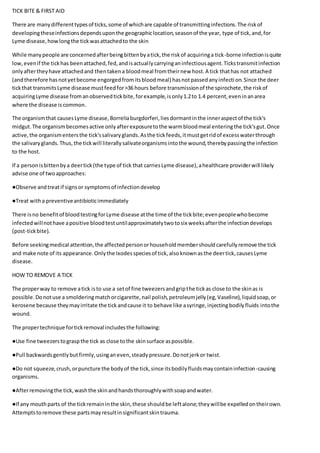
Tick bite ; first aid
- 1. TICK BITE & FIRST AID There are manydifferenttypesof ticks,some of whichare capable of transmittinginfections.The riskof developingtheseinfectionsdependsuponthe geographiclocation,seasonof the year, type of tick,and,for Lyme disease,howlongthe tickwasattachedto the skin While manypeople are concernedafterbeingbittenbyatick,the riskof acquiringa tick-borne infectionisquite low,evenif the tickhas beenattached,fed,andisactuallycarryinganinfectiousagent.Tickstransmitinfection onlyaftertheyhave attachedand thentakena bloodmeal fromtheirnew host.A tick thathas not attached (andtherefore hasnotyetbecome engorgedfromitsbloodmeal) hasnotpassedanyinfection.Since the deer tickthat transmitsLyme disease mustfeedfor>36 hours before transmissionof the spirochete,the riskof acquiringLyme disease fromanobservedtickbite,forexample,isonly1.2to 1.4 percent,eveninanarea where the disease is common. The organismthat causesLyme disease,Borreliaburgdorferi,liesdormantinthe inneraspectof the tick's midgut.The organismbecomesactive onlyafterexposuretothe warmbloodmeal enteringthe tick'sgut.Once active,the organismentersthe tick'ssalivaryglands.Asthe tickfeeds,itmustgetridof excesswaterthrough the salivaryglands.Thus,the tickwill literallysalivateorganismsintothe wound,therebypassingthe infection to the host. If a personisbittenbya deertick(the type of tick that carriesLyme disease),ahealthcare providerwill likely advise one of twoapproaches: ●Observe andtreatif signsor symptomsof infectiondevelop ●Treat witha preventiveantibioticimmediately There isno benefitof bloodtestingforLyme disease atthe time of the tickbite;evenpeoplewhobecome infectedwillnothave apositive bloodtestuntilapproximatelytwotosix weeksafterthe infectiondevelops (post-tickbite). Before seekingmedical attention,the affectedpersonorhouseholdmembershouldcarefullyremove the tick and make note of its appearance.Onlythe Ixodesspeciesof tick,alsoknownasthe deertick,causesLyme disease. HOW TO REMOVE A TICK The properway to remove atick isto use a setof fine tweezersandgripthe tickas close to the skinas is possible.Donotuse a smolderingmatchorcigarette,nail polish,petroleumjelly(eg,Vaseline),liquidsoap,or kerosene because theymayirritate the tickandcause it to behave like asyringe,injectingbodilyfluids intothe wound. The propertechnique fortickremoval includesthe following: ●Use fine tweezerstograspthe tick as close tothe skinsurface aspossible. ●Pull backwardsgentlybutfirmly,usinganeven,steadypressure.Donotjerkor twist. ●Do not squeeze,crush,orpuncture the bodyof the tick,since itsbodilyfluidsmaycontaininfection-causing organisms. ●Afterremovingthe tick,washthe skinandhandsthoroughlywithsoapandwater. ●If any mouthparts of the tickremaininthe skin,these shouldbe leftalone;theywillbe expelledontheirown. Attemptstoremove these partsmayresultinsignificantskintrauma.
- 2. AFTER THE TICKIS REMOVED Tick characteristics — It ishelpful if the personcanprovide informationaboutthe size of the tick, whetherit was actuallyattachedtothe skin,if itwasengorged(thatis,full of blood),andhow longitwasattached. ●The size and colorof the tickhelpto determinewhatkindof tickitwas; ●Ticksthat are brownand approximatelythe size of apoppyseedorpencil pointare deerticks.These can transmitBorreliaburgdorferi (thebacteriumthatcausesLyme disease) andanumberof othertick-borne infections,includingbabesiosisandanaplasmosis. ●Ticksthat are brownwitha white collarandabout the size of a pencil eraserare more likelytobe dogticks (Dermacentorspecies).Theseticksdonotcarry Lyme disease,butcanrarelycarry anothertick-borne infection calledRockyMountainspottedfeverthatcan be seriousorevenfatal. ●A brownto blacktickwitha white splotchonitsbackis likelyafemale Amblyommaamericanum(Lone Star tick;namedafterthe white splotch).Thisspeciesof tickhasbeenreportedtospreadan illnesscalledSTARI (southerntick-associatedrashillness).STARIcausesarash that issimilartothe erythemamigransrash,but withoutthe otherfeaturesof Lyme disease.Althoughthisrashisthoughttobe causedbyan infection,acause for the infectionhasnotyetbeenidentified.Thistype of tickcan alsocarry and transmitanotherinfection calledhumanmonocyticehrlichiosis. ●A tickthat was notattached,was easyto remove orjustwalkingonthe skin,andwas still flatandtinyandnot full of bloodwhenitwasremovedcouldnothave transmittedLyme disease or anyotherinfectionsince ithad not yettakena bloodmeal. ●Onlyticksthat are attached andhave finishedfeedingorare near the endof theirmeal can transmitLyme disease.Afterarrivingonthe skin,the tickthatspreadsLyme disease usuallytakes 24hoursbefore feeding begins. ●Evenif a tick isattached,it musthave takena bloodmeal to transmitLyme disease.Atleast36 to48 hoursof feedingisrequiredforatick to have fedandthentransmitthe bacteriumthatcauses Lyme disease.Afterthi s amountof time,the tickwill be engorged(full of blood).Anengorgedtickhasa globularshape andislarger than an unengorgedone. ●It isnot clearhowlong a tickneedstobe attachedto transmitbacteriaotherthanBorreliaburgdorferi. Needfortreatment — The clinicianwill reviewthe descriptionof the tick,alongwithanyphysical symptoms,to decide uponacourse of action. Recommendspreventive treatmentwithantibioticsonlyinpeople whomeet ALL of the followingcriteria: ●Attachedtickidentifiedasan adultor nymphal I.scapularis(deer) tick ●Tick isestimatedtohave beenattachedfor≥36 hours(baseduponhow engorgedthe tickappearsor the amountof time since outdoorexposure) ●The antibioticcanbe givenwithin72hoursof tickremoval ●The local rate of tickinfectionwithB.burgdorferi is≥20percent ●The personcan take doxycycline (eg,the personisnotpregnantorbreastfeedingora child<8 yearsof age) If the personmeetsALLof the above criteria,the recommendeddose of doxycycline isasingle dose of 200 mg for adultsand4 mg/kg,up to a maximumdose of 200 mg,in children≥8 years. If the personcannottake doxycycline,notrecommendedpreventivetreatmentwithanalternate antibioticfor several reasons:there are nodata to supporta shortcourse of anotherantibiotic,alongercourse of antibiotics
- 3. may have side effects,antibiotictreatmentishighlyeffectiveif Lyme disease weretodevelop,andthe riskof developingaseriouscomplicationof Lyme disease afterarecognizedbite isextremelylow. MONITORINGFOR LYME DISEASE Many people have incorrectinformationaboutLyme disease.Forexample,some people are concernedthat Lyme disease isuntreatableif antibioticsare notgivenearly(thisis untrue;evenlaterfeaturesof Lyme disease can be effectivelytreatedwithappropriateantibiotics).Manylocal Lyme disease networksandnational organizationsdisseminate unproveninformationandshouldnotbe the sole source of educationaboutLyme disease.Reputable sourcesare listedbelow. Signsof Lyme disease — Whetherornot a clinicianisconsultedafteratickbite,the personwhowasbitten(or the parents,if a childwas bitten) shouldobservethe areaof the bite forexpandingredness,which would suggesterythemamigrans(EM),the characteristicrashof Lyme disease . The EM rashis usuallyasalmoncoloralthough,rarely,itcan be an intense red,sometimesresemblingaskin infection.The colormaybe almostuniform.The lesiontypicallyexpandsoverafew daysor weeksandcan reach over20 cm (8 inches) indiameter.Asthe rashexpands,itcanbecome clear(skin-colored) inthe center. The centerof the rash can thenappeara lightercolorthanitsedgesor the rash can developintoaseriesof concentricringsgivingita "bull'seye"appearance.The rashusuallycausesnosymptoms,althoughburningor itchinghasbeenreported. In people withearlylocalizedLyme disease,EMoccurs withinone monthof the tick bite,typicallywithinaweek of the tickbite,althoughonlyone-thirdof people recall the tickbite thatgave themLyme disease.Components of ticksalivacan cause a short-lived(24to48 hours) rashthat shouldnotbe confusedwithEM. Thisreaction usuallydoesnotexpandtoa size largerthana dime. Approximately80percentof people withLyme disease developEM;10 to 20 percentof people have multiple lesions.If EMor othersignsor symptomssuggestive of Lyme disease develop,the personshouldsee a healthcare providerforproperdiagnosisandtreatment
